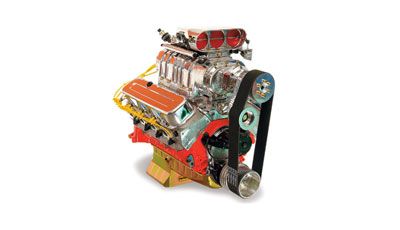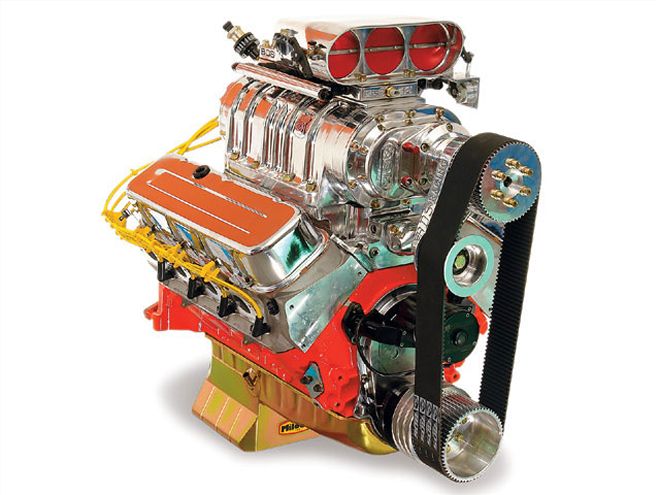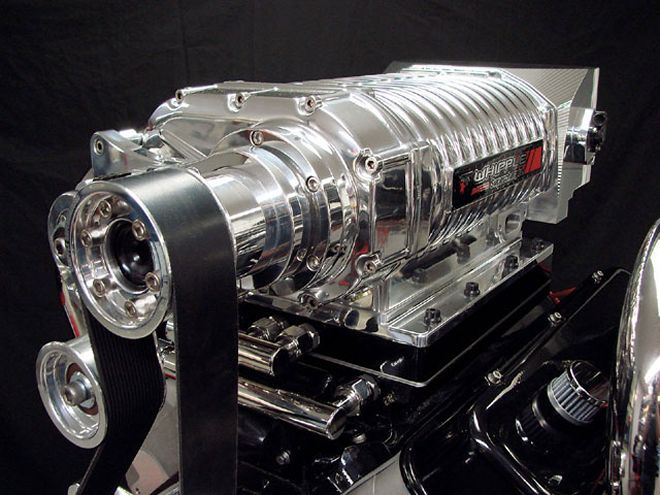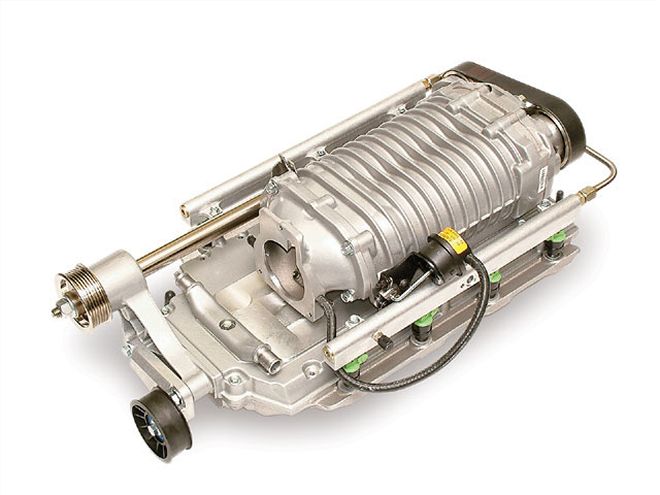

An English major may disagree, but the way to spell "power" is "supercharger." Let's face it, the word just reeks of big horsepower numbers-and not without good reason. The basic definition of "super" is "more than," and in this instance, it implies charging a cylinder with "more air than" a normally aspirated cylinder would.
So much for a fundamental definition of what a supercharger does. Now let's pose a question that has a less-than-obvious answer. Why supercharge, why not just more cubes? The fact of the matter is that a piston/rod/crank system is very effective at taking a source of high-pressure gas and turning it into rotating mechanical energy at the end of the crankshaft. Such a mechanism is not only mechanically far more efficient than is often accredited, but is also relatively effective in terms of size and component weight necessary to do so. Nonetheless, it is far less capable of moving atmospheric air at just less than 15 psi absolute (pressure above a total vacuum) from outside of the engine to inside the cylinder. For this operation, a piston/rod/crank is a heavy, cumbersome mechanism in terms of component size for the mass of air induced. In essence, any supercharger of merit is, size for size, a far more effective means of moving significantly greater quantities of air than a piston/rod/crank system. If you want absolute proof of what is being said here, just check the size of a turbo compared to the engine it's feeding. A turbo of about one twentieth of the size of an engine can pass as much as four to five times the volume of air. By utilizing a supercharger of any type, we are in effect making the engine act as if it has far more cubes because the magnitude of the induction process is now determined by the supercharger, not the basic displacement of the long-block itself.
 <strong><br>The Whipple Blower</strong></br>A casual look at the Whipple supercharger might lead you to the conclusion that it is a Roots blower with a very high helix angle. Not so; it actually belongs to a class of compressor known as a screw compressor. To see how it works, take a look at the second illustration.First, imagine these two rotors housed in a case with an opening at the upper back, and a discharge at the lower front. Starting from the left, imagine that the groove on the righthand rotor is full of air. As the lobe of the lefthand rotor rotates into this groove (middle), it can be seen to close off any exit toward the back where the intake is. This traps air in the groove, and as further rotation takes place the air trapped in the groove gets pushed forward as per the right pair of rotors. This squeezing action to compress the air takes place very efficiently with figures rivaling that of a turbo.
<strong><br>The Whipple Blower</strong></br>A casual look at the Whipple supercharger might lead you to the conclusion that it is a Roots blower with a very high helix angle. Not so; it actually belongs to a class of compressor known as a screw compressor. To see how it works, take a look at the second illustration.First, imagine these two rotors housed in a case with an opening at the upper back, and a discharge at the lower front. Starting from the left, imagine that the groove on the righthand rotor is full of air. As the lobe of the lefthand rotor rotates into this groove (middle), it can be seen to close off any exit toward the back where the intake is. This traps air in the groove, and as further rotation takes place the air trapped in the groove gets pushed forward as per the right pair of rotors. This squeezing action to compress the air takes place very efficiently with figures rivaling that of a turbo.
Supercharger TypesBasically, there are two fundamental types of superchargers: The positive-displacement type, and all the rest that are not. The best-known positive-displacement supercharger or blower is the Roots type. Originally developed in England by the Roots brothers to pump air into deep mine shafts during the middle of the 1800s, this type of pump started to see use on aircraft engines late in WWI. Although this style was successfully used between the wars on Mercedes and Auto Union F1 cars, and the highly successful British ERA F2 cars, they really came to the forefront when the likes of Don Garlits and a few other Top Fuel racers of the late 1950s and early 1960s figured they could go faster with a blower atop the motor-and they did. Back then, the blower of choice (because there was not a lot else to choose from) was the GMC supercharger used for supercharging GM's two-cycle diesel. The sizes most commonly used were the 6-71 and the 8-71. These big blowers could puff about 20-25 psi into a Chrysler Hemi and bump the output to what was then an incredible 2,500 or so horsepower, and about 3,200 lb-ft of torque. Today, we see many superchargers that owe their heritage to the GMC range of blowers. A few examples are those from Holley/Weiand, Edelbrock, Magnuson, I-Charger, BDS, Littlefield, and Eaton. When taking a casual look at this type of supercharger, it is easy to assume it draws the air into the middle of the rotors and passes it down into the manifold. In reality, this does not happen. The best way to see how it works is to look at a small-block Chevy oil pump, as this is in fact a mini Roots-type pump.
In its original form and right up through the late 1980s, the big drawback with the Roots blower was its relatively inefficient (about 55 percent) pumping characteristics. Here, substantial credit can be given to ace blower designer Jerry Magnuson; his efforts to improve the Roots-style positive-displacement blower have brought its efficiency throughout the typical operating range and duty cycle to a level closely comparable to a turbo-style supercharger. To put that into perspective, he has in the last 20 years done what engineers in the previous 120 years largely failed to do. Today, 98 percent or more of the superchargers sold have Magnuson technology in them. In other words, your modern Roots-style supercharger is not the one your father knew.
The Roots-type supercharger, though, is not the only positive-displacement style available. Among the many others in this category are the Zoller vane-type supercharger, the novel (and supposedly very efficient) VW G-Lader, and the Whipple-style screw compressor. Of these, only the Whipple unit, also a high-efficiency unit, is in any kind of aftermarket volume production.
The Magnuson BlowerThe simplest Roots superchargers are still very much like the Chevy oil pump, but some of the most advanced, such as the Magnuson shown here, have evolved dramatically. Instead of being nearly straight, the rotors have a steep helix and are now classified as hybrid Roots/screw compressors. Shown here is the latest high-efficiency design from Magnuson. Instead of the classic top surface air entry, the air enters at the front of the unit. A vacuum-referenced bypass butterfly equalizes the supercharger inlet pressure with manifold pressure. This virtually eliminates all parasitic losses other than the unit's bearing losses. This means the impact on cruise mileage is virtually zero. The form of the case discharge into the manifold has also been refined. Mounting a modern super-efficient unit on an intercooled base/intake manifold complements the setup, and is the key to higher power on otherwise lower-octane fuel."> <br><strong>The Magnuson Blower</br></strong>The simplest Roots superchargers are still very much like the Chevy oil pump, but some of the most advanced, such as the Magnuson shown here, have evolved dramatically. Instead of being nearly straight, the rotors have a steep helix and are now classified as hybrid Roots/screw compressors. Shown here is the latest high-efficiency design from Magnuson. Instead of the classic top surface air entry, the air enters at the front of the unit. A vacuum-referenced bypass butterfly equalizes the supercharger inlet pressure with manifold pressure. This virtually eliminates all parasitic losses other than the unit's bearing losses. This means the impact on cruise mileage is virtually zero. The form of the case discharge into the manifold has also been refined. Mounting a modern super-efficient unit on an intercooled base/intake manifold complements the setup, and is the key to higher power on otherwise lower-octane fuel.
<br><strong>The Magnuson Blower</br></strong>The simplest Roots superchargers are still very much like the Chevy oil pump, but some of the most advanced, such as the Magnuson shown here, have evolved dramatically. Instead of being nearly straight, the rotors have a steep helix and are now classified as hybrid Roots/screw compressors. Shown here is the latest high-efficiency design from Magnuson. Instead of the classic top surface air entry, the air enters at the front of the unit. A vacuum-referenced bypass butterfly equalizes the supercharger inlet pressure with manifold pressure. This virtually eliminates all parasitic losses other than the unit's bearing losses. This means the impact on cruise mileage is virtually zero. The form of the case discharge into the manifold has also been refined. Mounting a modern super-efficient unit on an intercooled base/intake manifold complements the setup, and is the key to higher power on otherwise lower-octane fuel.
Turbos And Centrifugal SuperchargersUnlike positive-displacement superchargers (which, barring leakage, move a certain amount of air per revolution), centrifugal superchargers develop boost by imparting motion into the air. When the air meets a resistance to this motion, the slowing of the air turns the kinetic energy into pressure energy. For that reason, the boost and airflow throughput of a turbine supercharger are very much interdependent on the characteristics of the engine it is feeding. About this moment, it's worth making a very pertinent point concerning boost. Most people think that a supercharger's whole existence is to develop boost, and as obvious as that may seem to be, it's not quite true. If the goal is the biggest boost number possible, then be aware that welding the intake valves closed will produce the highest boost, but not much power. The real job of a supercharger is to move the greatest mass of air through an engine, which then must subsequently use it effectively. A turbine supercharger can move a great deal of air very effectively. Also, since a centrifugal supercharger's mode of operation does not involve so much beating of the air, it can, when optimally designed, do so with high efficiency. But there is a downside: its speed sensitivity. As the turbine spins, the boost goes up with the square of the rpm. This means at low speed minimal boost, and at high speed possibly too much boost. Fortunately, a lot of work over the years by a bunch of smart engineers has brought about a number of moves that minimize this characteristic.
To see how the "too much upstairs and not enough low down" situation has been addressed, let us first look at a turbocharger installation. What we have here is an intake turbine driven by a shaft powered by a turbine fed via the engine's exhaust. In simple terms, the exhaust energy is driving the intake compressor turbine. The general principle is to size the intake turbine such that it is a little too big for the job at high speed. This means it starts to boost the engine sooner, but if left to its own devices, would provide too much boost at high speed. To prevent this, the exhaust side has an exhaust wastegate. When the boost reaches a certain predetermined level, the wastegate opens and bypasses any excess exhaust beyond what is needed. Along with impeller design, this characteristic and the inlet sizing helps spread a turbo's boost range down into the lower rpm band.
For a mechanically driven turbine supercharger (ProCharger, Vortech, Paxton) of the type originally pioneered by Paxton 60 years ago, we find the situation a little different. Because the drive ratio between the supercharger and the engine is fixed (Paxton did actually develop a variable drive unit used on Ford Thunderbirds back in the late 1950s), limiting top end boost while trying to enhance low-speed boost comes down mostly to impeller design and overall unit sizing. In that area, significant strides have been made just in the last 15 years.
Bolt-On Power: Making A ChoiceThe heyday for blowers of any type starts now, and goes into the near foreseeable future. As for those of you concerned that the push for fuel economy may spell the end of big power, fear not. There are plenty of ways to employ a supercharger to both enhance performance and improve mileage-and that means they are not going away anytime soon. If you are in the market for additional power in the form of a bolt-on, then your only problem is making a decision as to which system you should use.
When Low-Speed Torque Sets The RulesIf you have a truck (like me) that you want performance from, but it really has to function as a truck and do useful work, then a positive-displacement unit is almost certainly the way to go. My 2000 4.8 GMC Sierra has to haul a payload as much as 10,000 pounds when taking the race car to the track. To do this effectively, it needed real low-speed grunt, along with the capability to deliver good mileage. Up to this point, I had experience with the Holley/Weiand kits, Magnuson, Edelbrock, and Whipple, but mostly with the Holley/Weiand and Magnuson stuff. A few years ago, on a mild-cammed 350 with pocket-ported aluminum heads, I saw some 541 hp and 545 lb-ft using a Holley/Weiand blower. That's a pretty good showing for what is essentially one of the lower-cost installations on the market. But since the truck was to be used for long-haul towing, mileage was very much on my mind, and I had not, up to this point, tested a Magnuson setup with the bypass valve. This valve, also used on the Edelbrock blowers, reduces parasitic losses to barely above what it takes to spin a couple of sets of roller bearings. So with mileage in mind, I selected a bypass-valve-equipped positive-displacement kit, in this instance from Magnuson. Because the Magnuson kit was charge cooled via a water-to-air intercooler between the blower and block, it could manage 8 psi on a 9:1 engine without being detonation-prone or octane-sensitive. To make the most of the blower, the stock 4.8 heads were ported, and a Gale Banks exhaust system installed. Dyno tuning was done at Custom Performance, and PCMforless burned a custom program for us. Results were very satisfying. Quarter-mile performance showed up just short, by a truck's length, when run against a stock '04 Mustang GT. Freeway mileage just missed the 21-mpg mark by a hair's breadth, while a consistent 17 mpg was seen about town. That was virtually unchanged from stock. When towing, mileage was surprisingly good. I saw low 14s. Maybe the trick for performance and mileage is a smaller engine with an efficient blower. Since I tested this unit from Magnuson, they have made yet another significant step forward in rotor design. In fact, as we go to press, rotor design seems to be a hot topic and some new developments from Edelbrock are in the works. Some insider info indicates we should stay tuned on this one.
At this point, we can say that for off-idle and low-speed torque, a positive-displacement blower is the ticket. But what if you are happy with the output of your engine up to about the 2,000-2,500-rpm mark? If that's the case, then a whole slew of supercharger types become a viable bolt-on option, and that's what we'll look at now.
Centrifugal SuperchargerFor the most part, the easiest installation is a belt-driven centrifugal blower, rather than a turbo. Although they may lack the low-speed capability of a positive-displacement blower, they can usually deliver a cooler boosted charge, thus allowing more power to be developed before an intercooler or water injection becomes necessary. That said, most installations still take advantage of boost cooling by an intercooler. As a result, a 10-psi ProCharger unit feeding an otherwise stock 4.6-liter, Three-Valve '07 Mustang shows some impressive bolt-on gains. A ProCharger kit, as per the Mustang shown on p. 64, was able to boost rear-wheel horsepower from typically 260 to just over 460.
This charge temperature factor is a strong point of any centrifugal-style supercharger with an efficient impeller. The bottom line is that when they get going, they move more air with less heating.
That is the underlying reason why, when it comes to big mid- and top-end numbers, a centrifugal supercharger is the way to go, but should you opt for a mechanical drive (belt-driven), or an exhaust-driven turbo setup?
Like the decision between positive displacement and centrifugal, there are pros and cons for each type of drive. A mechanically driven setup definitely has no turbo lag (which is totally fixable, and is hardly an issue these days), and unlike turbos with their hot exhaust housings, suffer less underhood heat loading. That said, ultimately a turbo setup, which recovers some of the lost exhaust energy, ends up the top contender for total output. Another advantage of the turbo is that it can be sized to come on sooner with the top end boost limited by the wastegate. At the end of the day, both types will produce dazzling performance from most otherwise stock engines-sufficiently so that the problem becomes one of getting all the power to the ground. If the engine is built for supercharging from scratch, the power potential becomes near insane. A couple of projects I have personally been involved with will put that into perspective. A Mustang with a ProCharger-equipped 351 Windsor turned up the dyno rollers to 850 hp, and at that point, just smoked the tires. I estimate it was still more than 1,000 rpm from peak power. A turbocharged small-block Chevy with a Performance Techniques installation, same deal. Both of these vehicles were most certainly over 1,000 rear-wheel horsepower. Even on the grippiest road tires available, neither of these cars would hook up under 120 mph. That's on a dry road. On a wet road, you had better have a good share of Michael Schumacher's driving skills just to survive. At the end of the day, here you need to look at cost and ease of installation, as well as personal preferences when making a decision as to which type of system you should go for. If that sounds way out in left field, Underground Racing's (Charlotte, North Carolina) street turbo Viper conversion is producing over 1,800 hp at the wheels. But let's get our feet back on the ground here. A more "bolt-on" turbo kit for an otherwise stock engine such as an LS series GM, or Ford's Three-Valve, unit will respond to the tune of a 200-300 hp increase, with a boost of 8-10 psi. A good example here is the kit offered by Turbonetics for '05-08 Mustangs. This boosts rear-wheel horsepower from the stock 250-260 to about 500, and all done with less than 10-psi boost.